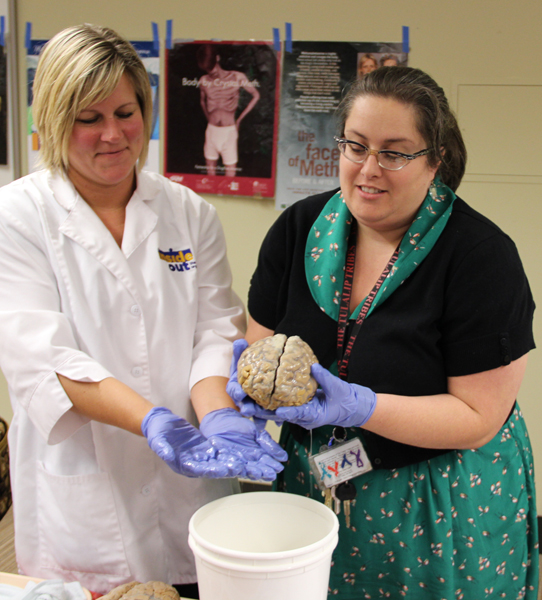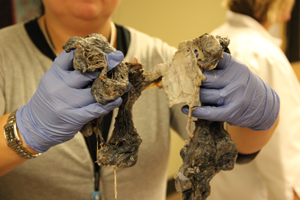
Photo: Andrew Gobin, Tulalip News
By Andrew Gobin, Tulalip News Reporter
Tulalip − The unsettling foreign smell of formaldehyde and isopropyl alcohol wafted from a table at the front of the room, lined with bottles, cans, jars of waste and toxins, and trays of human organs. Those who attended the CEDAR group meeting November 7th were disgustingly captivated by the uncanny presentation. Inside Out tells the gruesome truths of substance abuse, dispelling the misconceptions and myths society has about substances. Thursday’s show was unique, highlighting the effects of specific drugs.
Commonly referred to as the Organ Lady show, Inside Out begins with a glass of vodka and a raw egg. Shawneri Guzman, one of five Organ Ladies, cracks the egg into the glass for all to see, then sets it aside. From behind jars of tar and phlegm, Guzman picks up a set of human lungs, kicking the show into high gear as the audience leans in for a better look. She describes the different parts and facts about these lungs, which are grey and small, but they are healthy. Next she shows the lungs of a tobacco smoker, a marijuana smoker, and a heroin smoker, each looking progressively larger, shredded, and more black.

Photo: Andrew Gobin, Tulalip News
“The goal is to show healthy organs in comparison to damaged organs in order to help people understand what their choices are leading to, and hopefully help them make a change in their life,” said Guzman, an ER nurse at Providence Medical Center who sees people with these conditions on a daily basis.
The show continues with the heart, kidneys, liver, a tongue, and brains. Each specimen comes with a story, which Guzman tells while weaving in facts about drugs and how they are different and more dangerous today than they were ten, twenty, thirty years ago.
“The heroin on the street today is 60% to 70% pure, thirty years ago it was more like 20%. This means you can become addicted the first time, you can overdose the first time, you can die the first time. Today, heroin is commonly cut with horse tranquilizers, which is why so many people that use heroin look like zombies, they are essentially numbing their brain,” Guzman explained.
She continued to unveil brains, picking up slices that resembled Swiss cheese. Brains riddled with holes from heroin, meth, and marijuana, coupled with neural scans showing severe cognitive impairment illustrate a sobering reality. The damage shown in these brains is irreversible.
Guzman pointed out the misconceptions of drug use, such as smoking heroin is less addictive and less harmful than injection. If anything, smoking heroin is more harmful because of the drastic effect on the lungs.
It is important to know that second and third-hand marijuana exposure can cause you to test positive for THC, the chemical that comes from marijuana. Guzman referred to her experience in the ER, how many people come in after having tested positive for THC, and not knowing why it happened.

Photo: Andrew Gobin, Tulalip News
She explained, “We don’t realize how much our immediate environment affects us on a daily basis. Exposure to smoke is one example of how your surroundings affect your life. Even though you aren’t smoking, your body still feels the effects and it will show up on a test.” She noted that, “due to fertilizer and pesticides, marijuana today has more THC than what our parents would have smoked, meaning the effects and damage are both more drastic, and we are seeing more people test positive having only been exposed to third-hand smoke, which is the residue left on clothes, hair, furniture, and inside the car.”
As the show came to an end, Guzman picked up the egg floating in a glass of vodka. The vodka cooked the egg white in less than 90 minutes.
“Our brains do not stop maturing until we are about 25,” explained Guzman. “The egg white is immature protein, similar to a teen’s brain and other organs.”
She pointed out a liver from a 17 year-old girl that had drank since she was 13. It was hard and looked like a sponge in the middle.
Afterwards, people could put on gloves and examine the organs themselves, making the effects of substance abuse a tangible experience. Guzman continued to explain how these symptoms of organ damage manifest in living people, describing the signs to look for if you suspect someone is abusing substances. Awareness and understanding are crucial aspects in preventing addiction.
